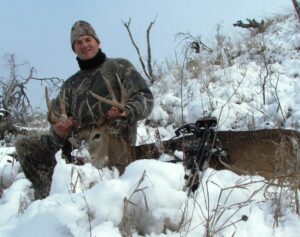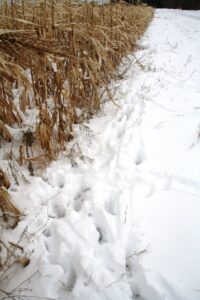You prepared for months, maybe even years, for your DIY hunt. You spent a week or more working hard and analyzing sign, wind currents, deer movements and any other clues you could. You hunted hard during the peak time of the year, but still came home with an unpunched tag in your pocket.
All is not lost. There may still be time for one last pass into the end zone, a “Hail Mary” so to speak. Have some time off over Christmas vacation? Can you get away for a long weekend the last few days of the season? Why not go back and give it one last try?

You may consider me crazy, but I love the very end of the whitetail seasons in the Midwest. Most of them wrap up around the New Year, but some states give you a couple weeks into January. This is the time of the year when the bucks may be in their most predictable patterns of all. They are focused on finding cover that protects them from the harsh weather, and finding enough high-carbohydrate foods to help their bodies fight off the cold. This can make them quite vulnerable to a hunter who is willing to brave the elements along with them.
If I can get away for one of these last minute hunts, I will head back to take advantage of the unique opportunities that late-season whitetail hunting offer. If this idea interests you, here are some suggestions to help assure you make the most of it.
Make some calls
Your first action should be to make a couple phone calls or send emails to biologists and conservation officers. Ask them specifics about where the deer are feeding. Ask them if they have seen herds of deer bunched up around a food source. They will have a feel for the numbers of mature bucks that made it through the gun seasons. Get some information about the weather. If it has been really cold and there is a lot of snow on the ground, the deer will be visible during daylight and predictably near the food sources.
Sign is Obvious
Once you arrive, it’s not hard to find the trails; snow makes travel patterns very obvious. Corn stubble will be stomped down and any standing soybeans, food plots and greens will be deer magnets. Read the sign, but also spend an evening glassing the food to determine where the bucks are entering the fields and at what times.
Keep in mind that the short hours of daylight can work against you, but really nasty weather can have even mature bucks out in the open an hour or two before dark. They have to eat to produce body heat and to restore fat reserves lost during the rut. Even the most shy bucks can be just as visible as they would be during August.
Dress accordingly
Cold weather means you need to bundle up, but still be able to prepare for a shot unimpeded by bulky clothing. Body suits and warm bags are available, some with heaters built right in. These have significantly increased the length of time a person can stay on stand during extreme cold weather.
Use moisture wicking base layers and fleece clothing as a way to trap heat between the inner and outer layers. Use a layering system that prevents you from getting all sweaty and damp when walking to the stand. Dampness will kill your comfort level faster than anything.
Take a ground blind
If you have ever sat in a treestand during December with wind chill temperatures well below zero, you know how difficult it can be. A ground blind allows you to get out of the wind, even to use a little heater to take the chill off. Bring a comfortable chair and you will be alert and ready when a buck does step into view.
Ground blinds are mobile; and advantage that allows you to get on the deer quickly. While plopping up a ground blind in the open during early fall might freak the deer out, they do not respond as negatively around winter food sources. They need to eat. Brush the blind in good with natural materials. Corn stalks work perfect. A white sheet draped over the blind will help break up the outline enough to calm them down.
Carbs are King
The deer will normally be found near the best food source available. The carbohydrates found in corn and soybeans readily convert to heat so they are eagerly sought. Mast crops can be important feeds at this time, but they get cleaned up quickly and the deer move on. Farms adjacent to public hunting lands can offer some of the best hunting opportunities.
The deer will spend their days bedding as near the food source as they can find good thermal cover. Short walks are the norm. Find the thick, weatherproof bedding areas, then find the high-carb foods and connect the dots. It really is that easy.
Consider an alternate weapon
In some states, your tag is good for multiple weapons. You may have spent the fall trying to punch your tag with a bow, but a muzzleloader might be a better choice for that late season hunt over a field where deer often feed just out of reach of your arrow. Muzzleloaders seem like the perfect fit for the mid-range shots that are so common during the final days of deer season.
Several states allow the use of a crossbow at this time. A crossbow is not a rifle that shoots an arrow as some would have you believe, but it will extend your range by about 50%, which might just be enough to close the deal. You don’t have to draw a frozen and potentially squeaky, creaky bow in the close proximity of an edgy whitetail, just raise the crossbow and pull the trigger.
Don’t throw your tag in the trash can after November. Prepare for cold weather and just go make it happen. Grind out a harsh weather, last minute “Hail Mary” trip and you might need to call the taxidermist after all.
